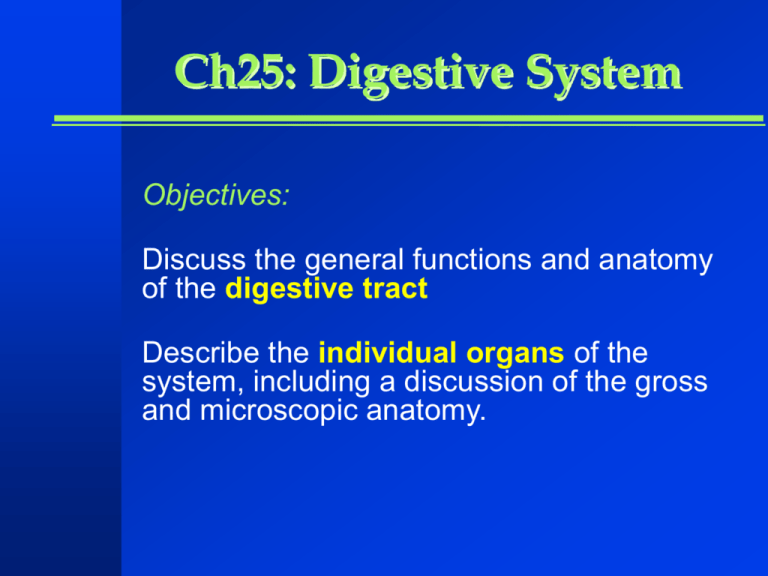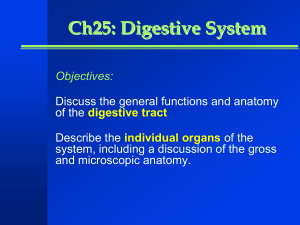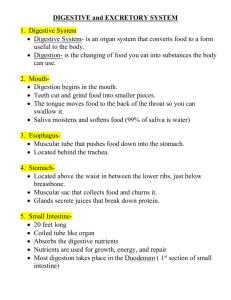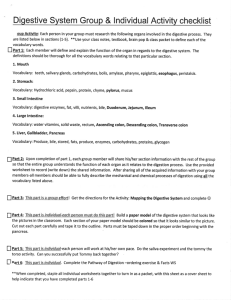Ch25: Digestive System
advertisement

Ch25: Digestive System Objectives: Discuss the general functions and anatomy of the digestive tract Describe the individual organs of the system, including a discussion of the gross and microscopic anatomy. Digestive System consists of: Muscular, hollow tube (= “digestive tract”) + Various accessory organs Function Individual parts function in: The function of the system as a whole is processing food in such a way that high energy molecules can be absorbed and residues eliminated. ingestion mechanical digestion chemical and enzymatic digestion secretion absorption compaction excretion and elimination Histological Organization Tube made up of four layers. Modifications along its length as needed. 1 2 Muscularis 3 externa 4 The 4 Layers of the Gut Fig 25.2 1) Mucosa Epithelium – usually simple columnar with goblets; may be stratified squamous if protection needed Lamina propria - connective tissue deep to epithelium Muscularis mucosae -produces folds - plicae (small intestine) or rugae (stomach) 2) Submucosa – made up of loose connective tissue contains submucosal plexus and blood vessels 3) Muscularis externa – smooth muscle, usually two layers (controlled by the myenteric plexus ) outer layer: longitudinal inner layer: circular 4) Serosa visceral layer of mesentery or adventitia depending on location Membranes Peritoneum - generic serous membrane in abdominal cavity Mesenteries - double sheets of peritoneum, surrounding and suspending portions of the digestive organs Greater omentum - "fatty apron", hangs anteriorly from stomach, double layer encloses fat Lesser omentum - between stomach and liver Mesentery proper - suspends and wraps the small intestine Mesocolon - suspends and wraps the colon, parts are i. transverse mesocolon Fig. 25.4 ii. sigmoid mesocolon Oral Cavity Also called buccal cavity - lined with oral mucosa (type of epithelium ?) Hard and soft palates - form roof of mouth Tongue - skeletal muscle Salivary glands - three pairs Teeth Three pairs of Salivary Glands 1-1.5 l / day for digestion (?) lubrication (swallowing) moistening (tasting) Parotid – lateral side of face, anterior to ear, drain by parotid duct to vestibule near 2nd upper molar – mumps Submandibular – medial surface of mandible – drain near lingual frenulum drain posterior to lower molars Sublingual – in floor of mouth - drain near frenulum Structure of Teeth Crown - exposed surface of tooth Neck - boundary between root and crown Fig 25.7 Enamel - outer surface Dentin – bone-like, but noncellular Pulp cavity - hollow with blood vessels and nerves Root canal - canal length of root gingival sulcus - where gum and tooth meet Types and Numbers of Teeth Dental succession Deciduous (baby, milk) teeth - 20, replaced by Permanent teeth - 32 teeth Gross Anatomy of the Stomach Lesser curvature Greater curvature Cardia - end under the heart Fundus - bulge above the esophageal opening Body - largest region Pylorus - J curve, inferior end, terminates in Cardiac and Pyloric sphincters (importance?) Rugae – highly extendable interior folds Figs 25-10/11 Histology of Stomach Fig 25.13 Type of epithelium lining stomach? Gastric pits – shallow pits, external half rapidly reproduces for replacement Gastric glands – deep in lamina propria, 3 types of cells 1. Parietal cells (produce HCl and intrinsic factor) 2. Chief cells (produce pepsinogen) 3. Enteroendocrine cells – G cells (several hormones including gastrin which stimulates both parietal and chief cells) Regions of Small Intestine SI is longest part of dig. tube Duodenum (short, 12 inches) – fixed shape & position – Mixing bowl for chyme & ? Jejunum (2.5 m long) – Most of digestion Ileum (longest at 3.5 m) – Most of absorption, ends in Ileocecal valve – slit valve into large intestine (colon) Structure of Small Intestinal Wall Fig 25.15 Plicae circulares – circular pleats around the interior of the small intestine Villi – minute finger-like projections, contain capillaries & lacteals Microvilli – sub-microscopic size, projections on single cells Function of all three? Intestinal glands (crypts) – intestinal juice production – Cell regeneration Histology in lab Regions of Large Intestine Cecum – pocket at proximal end with Appendix Colon Ascending colon - on right, between cecum and right colic flexure Transverse colon - horizontal portion Descending colon - left side, between left colic flexure and Sigmoid colon - S bend near terminal end Fig 25-17 Rectum – terminal end is anal canal - ending at the anus which has internal involuntary sphincter and external voluntary sphincter Histology of Large Intestine 1. Mucosa - abundant goblet cells, stratified squamous epithelium near anal canal 2. No villi 3. Longitudinal muscle layer incomplete, forms three bands or taenia coli 4. Circular muscle - forms pockets or haustra between bands Fig 25.19 Liver On right under diaphragm, largest organ made up of 4 lobes (left and right, caudate, and quadrate) Hilus (porta hepatis) – underside "entry" point Extremely versatile: Know a few functions? Gall bladder Blood supply to liver Microscopic anatomy: Liver lobules and triads Fig 25.20 Fig 25.21 Pancreas Retroperitoneal Endocrine or exocrine gland? Common bile duct and pancreatic duct lead to duodenal ampulla and papilla Compare to Figs 25-22 / 23











